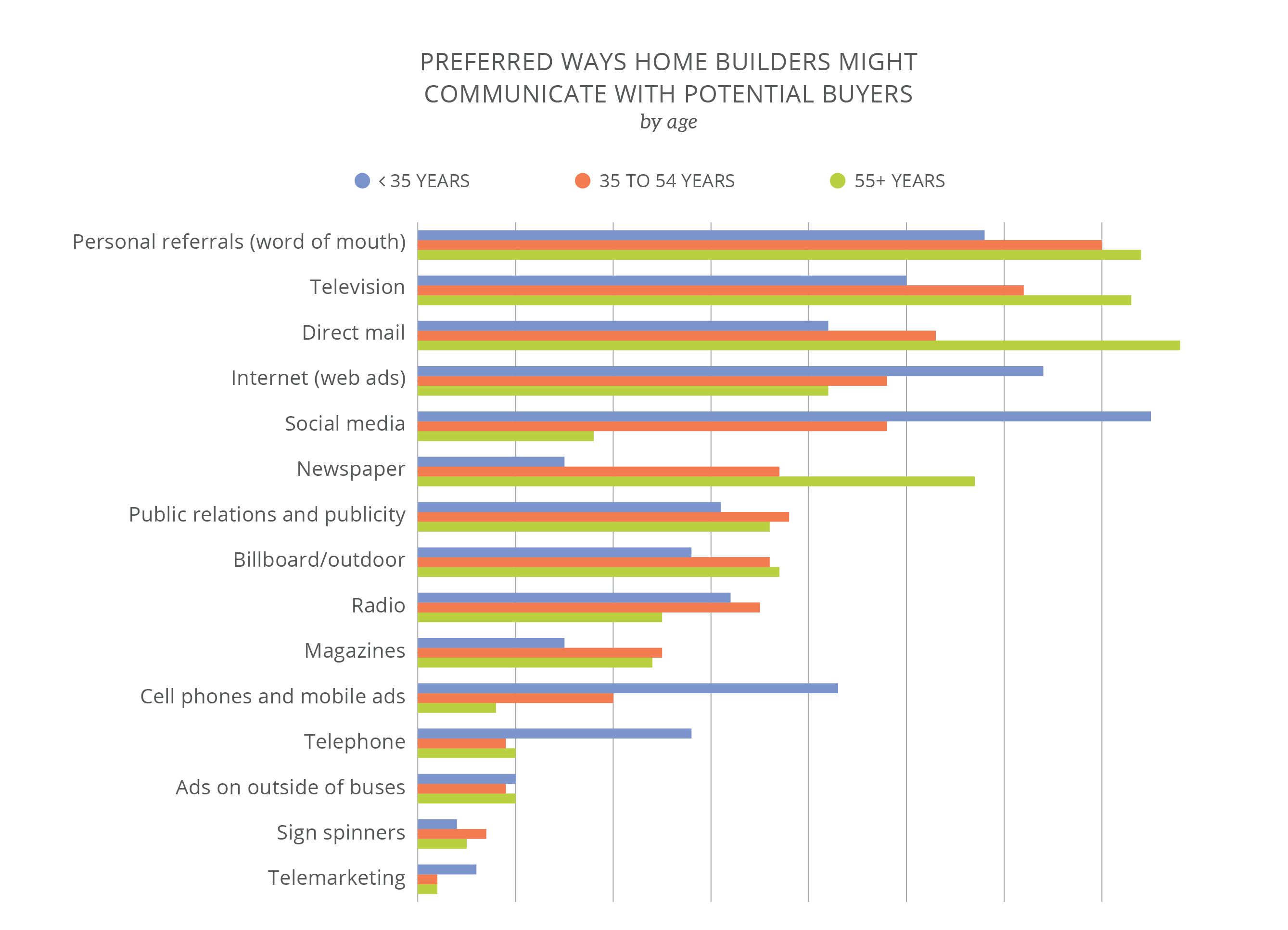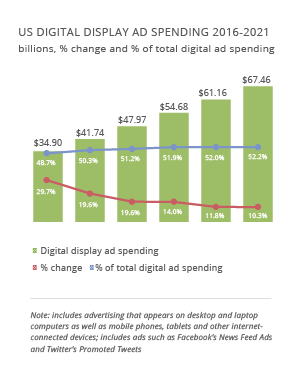Sign up for our LAVY email
and get our bi-monthly newsletter.

This article is a brief abstract of our exclusive study that takes the guesswork out
of marketing residential developments.
Download the complete 2018 Residential Development Marketing Report
Millennials conduct much of their personal and professional lives online, so it’s no surprise their home-buying messaging preferences are also digital. Our Southwest Residential Development Marketing Report revealed social media as their most-preferred mode of communication (74.6%) followed closely by Internet ads (64.0%). Only then does personal referral (word of mouth) come into play (57.9%)—a significant deviation from the 68.5% preference in overall study results.

In context, it makes sense. Emarketer.com published relevant data revealing affluent millennials who earn $100,000 or more per year log an average of 53 hours on the Internet each week. In comparison, equally affluent Gen Xers (35-51) spend 45.4 hours online, and baby boomers (52-70) use the Internet for 37.2 hours each week. In contrast, affluent seniors (71+) were online only about 28 hours per week.
Not all home builders cater to the young and upwardly mobile. With a current median age of 37.7 in the United States, chances are home builders are eager to capture the 35-54 demographic—typically in their family-rearing years and possibly ready to settle down or upgrade from a starter home to one suitable for their growing household.
To reach this middle cohort, a traditional prescription of personal referrals (word of mouth), television and direct mail is the way to go. Referrals topped out with 69.7% of research study respondents who chose the tactic as their most preferred way to learn about new homes. Television advertising followed closely behind at 62.3%. Direct mail came in third, ranking nearly 10 percentage points lower at 53.3%.
Candidates for active adult communities designed for seniors see things differently. Within the 55+ group, 78.2% favored direct mail pieces. Personal referrals (word of mouth) and television ranked neck and neck among research study respondents at 73.8% and 73.3% respectively.
Newspapers also deserve a prominent place in media outreach for home buyers aged 55+, with 68.8% of respondents in that demographic naming the traditional media tactic as their favorite.
Pew Research Center’s 2016 "State of the News Media" report backs up the viability of newspaper advertising. While circulations are shrinking and ad revenue (tied to ad spending) was down 10% in 2016 from 2015, which was slightly more than the 8% decline from revenue in 2014, newspaper ads still play a significant role.
Meanwhile, online marketing, including paid search and social ads as well as managing branded accounts on social media channels, is gaining momentum among home builders. It’s all part of a trend for the industry to dive deeper into the digital world. The LAVIDGE-commissioned research study revealed 49.3%—nearly half of all respondents—prefer online ads, the majority of which appear on Google and Facebook. This is in line with digital advertising trends in general.
“Google and Facebook have risen to the top for several reasons, including massive scale, huge amounts of audience data and easy-to-use automated systems for buying ads,” said eMarketer analyst Nicole Perrin in her December 2017 report, “Beyond the Duopoly: Exploring Digital Advertising Outside of Google and Facebook.”
 “It is something I read every day and actually look at the ads.”
“It is something I read every day and actually look at the ads.”Meanwhile, online marketing, including paid search and social ads as well as managing branded accounts on social media channels, is gaining momentum among home builders. It’s all part of a trend for the industry to dive deeper into the digital world. The LAVIDGE-commissioned research study revealed 49.3%—nearly half of all respondents—prefer online ads, the majority of which appear on Google and Facebook. This is in line with digital advertising trends in general.
“Google and Facebook have risen to the top for several reasons, including massive scale, huge amounts of audience data and easy-to-use automated systems for buying ads,” said eMarketer analyst Nicole Perrin in her December 2017 report, “Beyond the Duopoly: Exploring Digital Advertising Outside of Google and Facebook.”
 “You can customize what you are looking for and therefore not have to waste time on looking up things that are not important. On the Internet, you can weed out what you are not looking for and sort by what's important.”
“You can customize what you are looking for and therefore not have to waste time on looking up things that are not important. On the Internet, you can weed out what you are not looking for and sort by what's important.”An additional 41.3% of research study respondents stated a preference for social media as their source of marketing communication from new home builders.
Social media is an effective way to build online brand loyalty. On Twitter alone, D.R. Horton’s @DRHorton has built a following of 13.3k, KB Home’s @kbhome has attracted 16.8k followers, Pulte Group’s @PulteHomes has gained 29.5k followers and Shea Homes’ @Shea_Homes has a base of 3,350 followers with just as many more each for four additional Shea-branded handles localized for the Southwest. These include Arizona, Colorado, Northern California and Southern California. Lennar Homes’ @Lennar with 280.4k followers boasts more visibility than the previously named brands—combined.
 It’s becoming an increasingly competitive space. Searches for #newhome, #home builder, #customhome builder and other popular hashtags yield wide results. Residential builders are posting everything from tips on how to secure a mortgage to caring for one’s new home. Most also post information about their new communities and links to special sales events. Many feature pets or children. Others focus on amenities for active adults. Nearly all use images, often including practical information such as pricing and floor plans. Others feature warm, fuzzy, feel-good videos.
It’s becoming an increasingly competitive space. Searches for #newhome, #home builder, #customhome builder and other popular hashtags yield wide results. Residential builders are posting everything from tips on how to secure a mortgage to caring for one’s new home. Most also post information about their new communities and links to special sales events. Many feature pets or children. Others focus on amenities for active adults. Nearly all use images, often including practical information such as pricing and floor plans. Others feature warm, fuzzy, feel-good videos.
Facebook and Instagram are also jam-packed with home builders, along with Pinterest and Houzz. What’s new is the growing awareness among marketers to watch the activity of their social media accounts as much as the followers watch theirs. Home builders are now watching audience trends, behaviors, interests and demographics of their social followers to help fine-tune their messaging.
Social listening is not new, but for an industry newer to digital marketing in general, it’s just beginning to gain recognition as a way to generate leads—as it offers more highly targeted access to individuals based on demographics.
So, age really does matter. From millennials to those aged 55+, how one delivers marketing can make or break efforts to reach an intended audience. One would be wise to keep this in mind—and customize media strategies and messaging accordingly.

This article is a brief abstract of our exclusive study about home buyers and their preferences for advertising and marketing tactics used by new home builders.
Sign up for our LAVY email
and get our bi-monthly newsletter.